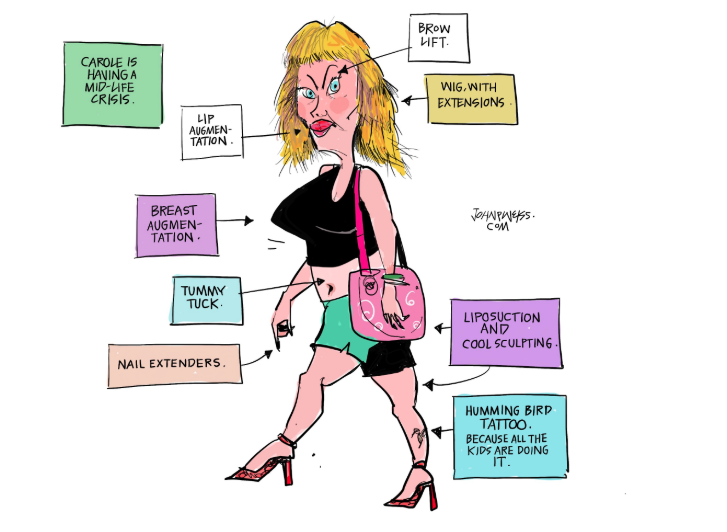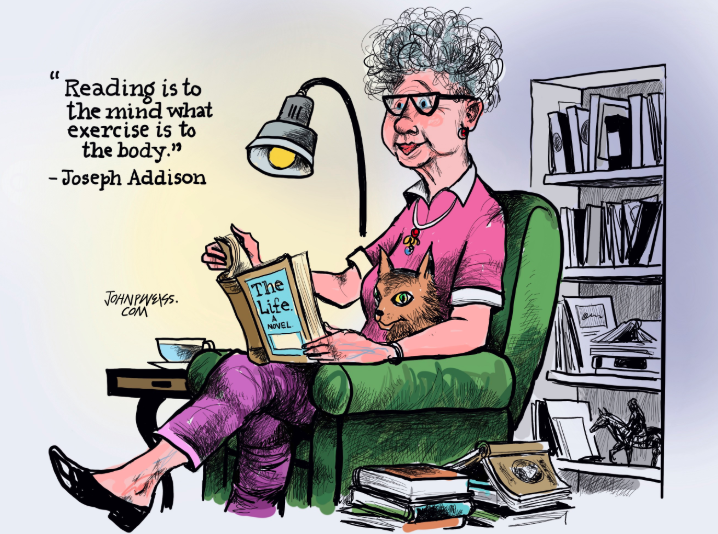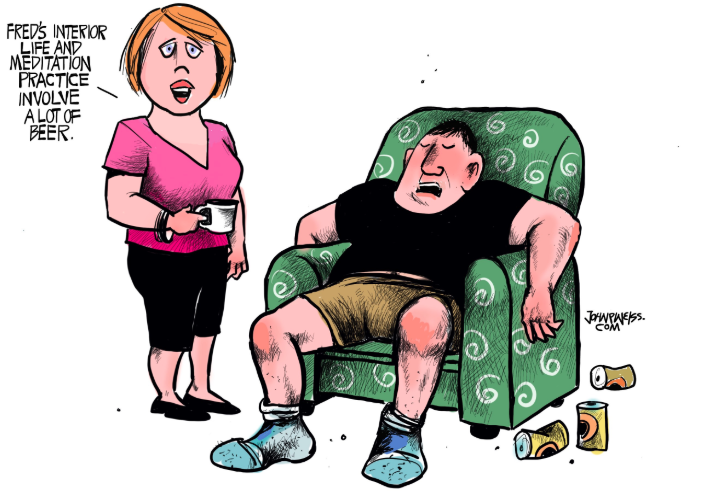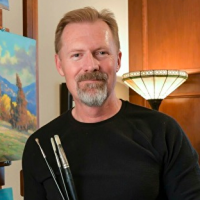My wife and I recently saw the movie “A Star Is Born,” starring Bradley Cooper and Lady Gaga.
The movie follows a hard-drinking, country music star (Cooper) who discovers and falls in love with a young, undiscovered singer (Gaga).
The movie is a remake of several earlier versions. My wife and I thought it was terrific. In one scene, Lady Gaga’s character impresses the country music star (Cooper) by singing a song she has written. They later perform the song together on stage. Here’s a trailer of that scene:
Besides the fact that Bradley Cooper and Lady Gaga sing beautifully together, what I love about the song is the lyrics. They contain an important question for all of us, as well as the promise of transcendence.
Are you happy in this modern world?
The duet that Bradley Cooper and Lady Gaga sing is called, “Shallow.” It opens with Cooper playing guitar and singing the following lyrics:
Tell me somethin’, girl
Are you happy in this modern world?
Or do you need more?
Is there somethin’ else you’re searchin’ for?
Lady Gaga responds with the following lyrics:
Tell me something, boy
Aren’t you tired tryin’ to fill that void?
Or do you need more?
Ain’t it hard keepin’ it so hardcore?
And finally, Lady Gaga belts out the bridge to the song, with the following:
I’m off the deep end, watch as I dive in
I’ll never meet the ground
Crash through the surface where they can’t hurt us
We’re far from the shallow now
How about you? Are you happy in this modern world? Are you far from the shallow? It’s an important question because, let’s face it, life can be hard.
Even Bradley Cooper’s character in the movie, despite all his fame and fortune, isn’t happy. He escapes with liquor. He’s stuck in the shallow of life.
Drowning in the deep end of life:
When we’re young, most of us get to experience several of life’s milestones. Stuff like getting our driver’s license. High school graduation. Turning 18 and being able to vote. Turning 21 and being able to hit the brewery.
For many, there is college and/or career beginnings. Marriage, maybe kids. Work promotions. Life has a structure and trajectory to it. We keep moving along, and don’t feel mired in the shallow of life. We’ve learned how to swim.
But then we start to age. The milestones of life slow down a bit. Divorces and layoffs can happen. Health challenges. We may not be in the shallow end of life anymore, but diving into the deep end brings its own hardships.
I’ve written about this before. The notion that diving in the deep end means there is a lot of water above you, bearing down. And water has weight.
The deeper you swim, the more pressure there is. Kinda like the longer you live, the greater the weight of all those years behind you. It can sometimes feel like you’re drowning in the deep end of life.
This difficult season in many people’s lives is often referred to as a “mid-life crisis.”

It’s a period when youthful looks are beginning to fade. The guy who was the football captain in college is now battling a beer gut and receding hairline. The gal who was a popular cheerleader in high school is noticing crow’s feet around her eyes and dimples on her thighs.
Time is not gentle. Doubts about our accomplishments and life’s purpose can start to gnaw away at our minds.
She has become invisible:
Author Doris Lessing (the 11th woman and oldest person ever to receive the Nobel Prize in Literature) explored this midlife crisis issue in her moving novel, The Summer Before Dark.
A review on Amazon.com noted that the book “…is a brilliant excursion into the terrifying gulf between youth and old age.”
The novel’s main character is Kate Brown, an attractive, intelligent, 45-year-old, married woman with a house in the London suburbs and three grown children.
Over the summer, her life changes substantially. Her husband leaves for a conference in the states, and she takes a position as an interpreter. She has an affair with a much younger man, and later she becomes quite ill.
Writer Joan Gage, referring to the novel in an article in the Huffington Post, recounts what happens next:
“By the time she’s well enough to get out of bed, Kate has lost 15 pounds, her clothes hang on her, her dyed red hair is coming out gray at the roots and her face has aged dramatically. As she weakly walks around London, even passing her own house, where her best friend doesn’t recognize her, Kate realizes that, by suddenly aging from an attractive, stylish, curvy redhead into a skeletal old hag in baggy clothes, she has become invisible.”
Clearly, Kate has not developed a strong interior life to weather the rigors of aging. She hasn’t learned how to transcend vanity and drink from the deeper wells of love, friendship, good books, and more mindful living.
An article in the website Honeygood.com notes:
“When you are emotionally fulfilled, you become a visible woman. You feel your step has a bounce and your laughter is contagious. You stand erect with great posture, with your head held high. You know you are respected by your husband, your family and your peers who see your relevancy, not your looks.”
Subtler means of being:
The reality is that we’ll all get there, at one time or another. We’ll all confront our diminishing looks, career obsolescence, invisibility, or general sense of irrelevancy.
So what do we do? How do we inoculate or rescue ourselves from the shallow of life? How do we cope with these unwanted challenges and realities of middle age and beyond?
Develop a strong interior life.
A strong interior life involves slowing down enough to read, think, reflect, and embrace a contemplative practice. It’s the complete opposite of today’s 24/7 pace. It’s about shutting off all those glowing devices and social media rabbit holes.

Each of us has an intimate conversation going on within ourselves. We’ve been doing it all our lives. That voice inside you, checking in. Questioning. Congratulating. Doubting. Worrying. Rejoicing.
When was the last time you really had a thoughtful conversation with yourself? The real you?
From Native American and Eastern spiritual traditions to today’s monotheistic religions and secular, mindfulness movements, human beings have sought purpose and meaning.
Developing an interior life is all about enriching the mind and soul. For some, it is a spiritual conversation. For others, it may be a metaphysical examination. Pragmatists may scoff and call it navel gazing, until the full weight of life slams them into reconsidering bigger questions.
Developing an inward life of balance, enrichment, and reflection is how we inoculate ourselves against the slings and arrows of worldly life. The unending march of daily living, with its commitments, responsibilities, and worries, stifles our ability to align with subtler means of being.
Forever in the shallows
According to an article in Psychology Today:
“Spiritual traditions have always insisted on maintaining the depth and dimensionality of life. They have developed practices to ensure that this occurs including meditation, contemplation and various forms of self-reflection. With the loss of religion more generally we have also lost these safeguards against staying forever in the shallows.”
The article goes on to note:
“The importance of creating both time and space for solitude was recognized across the world’s traditions and viewed as essential for psychological well-being and personal growth. Though the modes of self-cultivation varied these were linked to the ability to think deeply and to access higher modes of consciousness fostering positive states such as attitudes of compassion and gratitude.”
Monks and religious ascetics who choose a monastic life have always fascinated me. People like the monk James Finley. Perhaps they’re ahead of us, having figured out how to transcend the noise of daily life?
James Finley, Ph.D, lived as a monk at the secluded Trappist monastery of the Abbey of Gethsemani in Kentucky, where the world-renowned monk and author Thomas Merton was his spiritual mentor.
The Psychology Today article mentions Finley in the following quote:
“Commenting on the lack of space for introspection in contemporary life, James Finley argues that ‘It’s the crises of our age, the loss of the interior of our lives.’”
An inside job:
I recently read Anne Lamott’s new book, Almost Everything—Notes On Hope. Ever the eloquent writer, Lamott makes a better argument than I for why we need to develop a strong, interior life:
“There is almost nothing outside you that will help in any kind of lasting way, unless you are waiting for a donor organ. You can’t buy, achieve or date serenity. Peace of mind is an inside job, unrelated to fame, fortune or whether your partner loves you. Horribly, what this means is that it is also an inside job for the few people you love most desperately in the world. We cannot arrange lasting safety or happiness for our most beloved people. They have to find their own ways, their own answers.”
If developing your interior life sounds foreign to you, here are a few suggestions that might help.
>> Learn how to meditate. There are countless online resources to teach you the basics of proper posture and breathing.

>> Read broadly about how to develop a contemplative world view. Authors like Thomas Merton and the Dalai Lama may be helpful.
>> If you are religious, incorporate prayer into your daily routine. The act of praying can help you think about loved ones, yourself, others, and how to establish a stronger inner life and relationship with God.
>> Start keeping a journal, and set aside quiet time to write daily about your life, thoughts, feelings, and personal growth.
>> Embrace nature. Getting outdoors, breathing fresh air, and enjoying exercise in the great outdoors can help you appreciate life more.
>> Make time for quiet and stillness. This can be at home, in your car, or anywhere where you can take time to contemplate, reflect, and center yourself.
>> Daydream. We did this as children, but somehow abandon it in adulthood as a time waster. Daydreams can uncover solutions and deeper meaning in our lives.
>> Make your creative passions more of a priority. Here’s a helpful quote along those lines: “Aspire to live quietly, mind your own affairs and work with your hands.” ~ 1 Thessalonians 4:11
>> Help others. When we embrace kindness and humility toward others, good things happen. We become less selfish and egocentric. We worry less about vanity and wealth, and our sense of well-being and interior life improve.
>> Forgive. They say that anger is a hot coal. You can throw it at the person you’re angry with, but the coal still burns your hand. Forgiveness is a gift we give others, and ourselves. It’s not always easy, but well worth it.
>> Acceptance. Learn to accept the things you cannot change and focus on the things you can.
Superficial things:
I’m no authority on how best to develop a strong, fulfilling interior life. Maybe some of you are experts and can add to this essay. I only know that vanity, jealousy, comparison, and egocentrism do not serve us well in life. And unfortunately, so much of American culture is marinating in these superficial things (not to mention many other cultures).
If we fail to develop our intellectual curiosity, which is a part of a healthy, interior life, then we are left with more shallow tools to sustain us as we age. The internet, television, movies, and social media all have their place (in moderation). There’s nothing wrong with healthy entertainment, but such things aren’t enough to develop a strong interior life.
Our looks will fade and our bodies will slowly fail us. If we don’t learn how to develop a strong interior life, aging will be harder, and we might find ourselves marooned in the shallow of life.
Better to develop your inner life, and thereby live the words sung by Lady Gaga:
I’m off the deep end, watch as I dive in
I’ll never meet the ground
Crash through the surface where they can’t hurt us
We’re far from the shallow now











Read 3 comments and reply